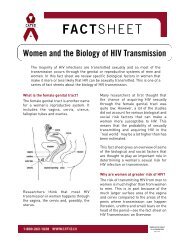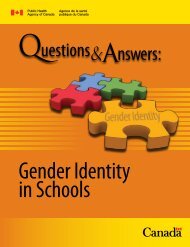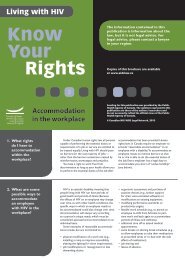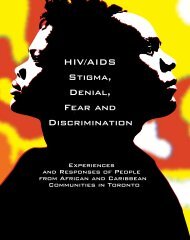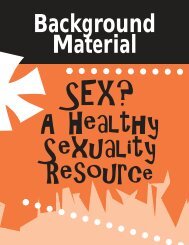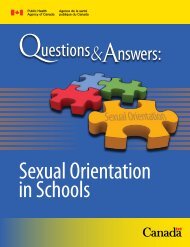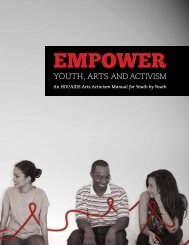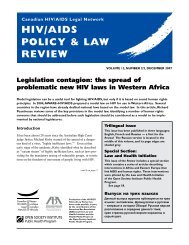Working with People who Use Drugs: A Harm Reduction Approach
Working with People who Use Drugs: A Harm Reduction Approach
Working with People who Use Drugs: A Harm Reduction Approach
Create successful ePaper yourself
Turn your PDF publications into a flip-book with our unique Google optimized e-Paper software.
[ Inside Front Cover ]Produced by the Public Awareness Task Group, Non Prescription Needle <strong>Use</strong> Initiative©2007 Canadian Liver Foundation#308, 10240 - 124 Street, Edmonton, AB T5N 3W6Toll free: 1-888-557-5516 | Email: clfedmonton@shaw.caReference:Non Prescription Needle <strong>Use</strong> Initiative. (2007). <strong>Working</strong> <strong>with</strong> people <strong>who</strong> use drugs: A harm reduction approach.Edmonton, AB: Author.
<strong>Working</strong> <strong>with</strong> <strong>People</strong> Who <strong>Use</strong> <strong>Drugs</strong>: A harm reduction approachTable of contentsIntroduction 3What is harm reduction? 4Core principles of harm reduction 7Individual harm reduction strategies and benefits 7Community harm reduction strategies and benefits 8<strong>Harm</strong> reduction: part of a comprehensive approach 11Developing a harm reduction policy 12Sample harm reduction policy 13Addressing common concerns about harm reduction 15Resources and contacts 18Inserts: <strong>Harm</strong> reduction in practiceAs a nurse or physicianAs a pharmacistAs a social worker or counsellorAs a police officerAs a corrections workerAs a community leaderInside back flapAcknowledgementsWe are grateful to the 30 Alberta professionals <strong>who</strong> offered their perspective on harmreduction and examples of practical experience using harm reduction strategies.Funding for this publication was provided by the Public Health Agency of Canada andHealth Canada.The opinions expressed in this publication are those of the authors and do not necessarilyreflect the official views of the Public Health Agency of Canada or Health Canada.Contributors:Ann Goldblatt, ConsultantCarmen Webber, Research AssistantClaire Verret, Graphic DesignCanadian Liver Foundation, Project SponsorNon Prescription Needle <strong>Use</strong> Initiative Public Awareness Task Group, Advisors
As a young woman, Jen used to injectmorphine and cocaine, often sharingneedles among several people. Duringthis time, Jen had a daughter. Shenever used when she was around herdaughter and did her best to be a goodparent. Jen had the support of a socialworker <strong>who</strong> taught her about the risksassociated <strong>with</strong> injecting. It took along time <strong>with</strong> several relapses, butJen was able to take small steps togain confidence and access thesupports she needed to deal <strong>with</strong>her addiction. Today, Jen is drug freeand her daughter is well cared for.Unlike many of her peers from longago, she does not have hepatitis C orHIV. Jen says that harm reductionsaved her life.
<strong>Working</strong> <strong>with</strong> <strong>People</strong> Who <strong>Use</strong> <strong>Drugs</strong>: A harm reduction approachIntroductionThis guide is a resource for professionals <strong>who</strong> work <strong>with</strong>people <strong>who</strong> use drugs. Recognizing that drug use cannot becompletely eliminated, you will find practical strategies toeffectively work <strong>with</strong> this population using a harm reductionapproach. This guide is an update to the <strong>Harm</strong> <strong>Reduction</strong>Information Kit for Professionals <strong>Working</strong> With At-Risk Populations(2000). The content presented here is largely based on30 interviews conducted <strong>with</strong> professionals working incommunities throughout Alberta.Throughout this guide, you will find stories about a rangeof people involved in drugs. These serve as a reminderthat drug use can touch any family from across the socioeconomicspectrum. <strong>People</strong> <strong>who</strong> use drugs are members ofthe communities where we work and live. Health and safety isas much as a concern for people <strong>who</strong> use drugs as it is for thegeneral population.The professional sheets (inserts in back flap) provide specificreasons, strategies and resources for using a harm reductionapproach for six professional groups that have an importantrole to play in harm reduction:• nurses and physicians• pharmacists• social workers and counsellors• police officers• corrections workers• community leadersYou are encouraged to look through the entire guide,including the professional sheets, as the value of the harmreduction concept and strategies extends to everyone <strong>who</strong>seservice brings them into contact <strong>with</strong> people <strong>who</strong> use drugs.It’s all about reducingharm rather than makingjudgments.– Aboriginal counsellorWe are your sons,daughters, fathers,mothers, brothers andsisters. 1In this guide, the terms “drug use” and “harmful substanceuse” refer to the use of illicit drugs and other substances inways that cause harm.1Canadian HIV/AIDS Legal Network. (2005). Nothing about us <strong>with</strong>out us: A manifesto by people <strong>who</strong> use illegal drugs.Toronto, ON: Author.
<strong>Working</strong> <strong>with</strong> <strong>People</strong> Who <strong>Use</strong> <strong>Drugs</strong>: A harm reduction approachSupporting harmreduction does not meanwe agree <strong>with</strong> drug use.– Pharmacy educatorWe look at reducingemotional, physical andspiritual harms.– Aboriginal elderWhat is harm reduction?“<strong>Harm</strong> reduction” is a pragmatic, non-judgmental set of strategiesto reduce individual and community harm caused by drug use. Thefocus is on taking incremental steps to reduce harm rather than oneliminating drug use. Abstinence may or may not be the end goal. 2For people <strong>who</strong> use drugs, harm reduction aims to prevent thespread of infections (including HIV/AIDS, hepatitis C and otherblood-borne infections); reduce the risk of overdose and otherdrug-related fatalities; and decrease the negative effects druguse may have on individuals and communities. 3 The CanadianCentre on Substance Abuse found that the direct (i.e., healthcare, enforcement, prevention and research) and indirect (e.g.,productivity loses, fire damage, etc.) social costs of illegal drugsin Canada in 2002 were $8,244,300. In that same year, 1,695Canadians died as a result of illegal drug use – that’s 62,110potential years of life lost. 4<strong>Harm</strong> reduction strategies are evidence-based and most effectivewhen adopted as a community-wide approach. <strong>Harm</strong> reduction isonly one in a series of parallel strategies to address substance issues<strong>with</strong>in a community; other strategies include prevention, treatmentand enforcement.For the general population, <strong>with</strong> or <strong>with</strong>out substance use issues,harm reduction is not a distant concept. It is part of daily life,including wearing a seat belt or choosing not to drink and drive.Core principles of harm reductionService providers and community leaders can be inspired and guidedby the following six core principles of harm reduction that have beenadapted from the Canadian Centre on Substance Abuse. 2➊ Pragmatism<strong>Harm</strong> reduction recognizes that there will always be a percentageof the population <strong>who</strong> will engage in higher risk behaviour, for arange of social, economic, mental health and personal reasons.<strong>Harm</strong> reduction recognizes that drug use is a complex andmultifaceted phenomenon that encompasses a continuum ofbehaviour from abstinence to chronic dependence, and producesvarying degrees of personal and social harm.2Thomas, G. (2005). <strong>Harm</strong> reduction for special populations: <strong>Harm</strong> reduction policies and programs for persons involved in the criminal justice system.Ottawa, ON: Canadian Centre on Substance Abuse.3International <strong>Harm</strong> <strong>Reduction</strong> Association. (2007). What is harm reduction? Retrieved May 14, 2007, from http://www.ihra.net4Canadian Centre on Substance Abuse (2006). The cost of substance abuse in Canada in 2002. Ottawa: Author.
<strong>Working</strong> <strong>with</strong> <strong>People</strong> Who <strong>Use</strong> <strong>Drugs</strong>: A harm reduction approach➋ Focus on harmThe priority for harm reduction is to decrease the negativeconsequences of drug use to the user and others, rather thanto decrease or eliminate drug use itself. While harm reductionemphasizes a change to safer practices and patterns of drug use,it does not rule out the longer-term goal of abstinence. In thisway, harm reduction is complementary to the abstinence model ofaddiction treatment.➌ Human rights<strong>Harm</strong> reduction respects the basic human dignity and rights ofpeople <strong>who</strong> use drugs. It accepts one’s decision to use drugs asfact; no judgment is made either to condemn or support the useof drugs. <strong>Harm</strong> reduction acknowledges the individual’s right toself-determination and supports informed decision-making in thecontext of active drug use. Emphasis is placed on personal choice,responsibility and self-management.➍ Maximizing intervention options<strong>Harm</strong> reduction recognizes that people <strong>with</strong> drug use problemsbenefit from a variety of approaches. There is no one prevention ortreatment approach that works reliably for everyone. It is choice andprompt access to a broad range of interventions that help to keeppeople alive and safe, and promote health.➎ Priority of immediate goals<strong>Harm</strong> reduction recognizes readiness to change as key to the processof individuals leading healthier lives. <strong>People</strong> may be anywhere alonga continuum – from not thinking about change, to contemplating it,to taking action, to maintaining change – moving forward and back.<strong>Harm</strong> reduction starts <strong>with</strong> “where the person is” <strong>with</strong> their druguse, <strong>with</strong> the immediate focus on the most pressing needs. <strong>Harm</strong>reduction is based on the importance of incremental gains that canbe achieved over time.➏ Involvement of people <strong>who</strong> use drugsThe active participation of people <strong>who</strong> use drugs is at the heart ofharm reduction. <strong>People</strong> <strong>who</strong> use drugs are seen as the best sourceof information about their own drug use, and are empowered to join<strong>with</strong> service providers to determine the best interventions to reduceharm from drug use. <strong>Harm</strong> reduction recognizes the competency ofpeople <strong>who</strong> use drugs to make choices and change their lives.You’ve got to startwhere they are. Sure,it’s preferred that theyget off altogether. Butrealistically, how will youreduce the risk in the shortterm so they are around inthe long term?– Community physician<strong>Harm</strong> reductionrespectfully meets people<strong>who</strong> use drugs “wherethey are at” and respondsto their health concerns.They are the ones <strong>who</strong>guide the process ofchange. 5We needed to make someprogram changes so weasked out clients forsuggestions. They came up<strong>with</strong> the best ideas!– Methadone programsupervisor5Streetworks (2007). Retrieved March 25, 2007 from http://www.streetworks.ca/pro/harmreduction.html
Ryan is 27 years old. He grew up infoster care and group homes. He startedto use drugs in his early teens and hadbeen injecting morphine daily for 10years, often living on the street. He hadbeen through addiction treatment, anddespite many attempts to quit, he alwaysended up back on drugs. Ryan becamesick, and tested positive for hepatitis C.His doctor suggested he consider goingon methadone to manage his addiction.Through relationships <strong>with</strong> staff andunderstanding the choice was his, hedecided the methadone program wasright for him. That was two years ago.Methadone has done wonders for Ryan’slife; he is now stable, holding a joband planning on getting married nextmonth. Methadone allows Ryanto function normally and maintaingood health.
<strong>Working</strong> <strong>with</strong> <strong>People</strong> Who <strong>Use</strong> <strong>Drugs</strong>: A harm reduction approachIndividual harm reduction strategiesand benefits<strong>People</strong> <strong>who</strong> use drugs can take small steps to reduce harm tothemselves and others:• Practice safer sex to prevent the spread of infection.• Know one’s dealer to establish the source, the strengthand the toxicity of the drug.• Reduce the amount of drugs consumed.• Avoid using drugs alone.• <strong>Use</strong> a different vein every time to inject.• Always use a new, sharp rig and fresh water, spoons and cotton.• <strong>Use</strong> needle and syringe exchange programs.• Dispose of used needles in sharps containers.• Learn CPR and other first aid strategies.• Consider an opiate substitute such as methadone.<strong>Harm</strong> reduction is givingcontrol back to the person.– Addictions counsellorIf you look at your ownaddictive tendencies, yourfirst reaction is to get yourback up if someone tellsyou what to do.– Social workerBeyond safer drug practices, people <strong>who</strong> use drugs can get otherkinds of support for health and related concerns, and can offera voice of experience:• Get support for physical and mental health concerns, housingor basic necessities, legal problems, employment concerns andrelationship issues.• Join a support group.• Take part in committees and other activities that are makingchanges in programs and policies affecting the health and wellbeingof people <strong>who</strong> are involved in drug use.Individual benefits include:• Prevention of infection by HIV, hepatitis C and other bloodbornepathogens.• Fewer overdoses.• Reduced chaos associated <strong>with</strong> drug seeking, leading to stability,through methadone maintenance treatment.• Increased sense of control: as a person gains more control overhow they use, they may be able to control when and if they willuse, however incremental the process may be.• Options to a person <strong>who</strong> may not have perceived any choices.• Increased capacity for self care.• Opportunities to link <strong>with</strong> sources of support.
<strong>Working</strong> <strong>with</strong> <strong>People</strong> Who <strong>Use</strong> <strong>Drugs</strong>: A harm reduction approachAs we have seen timeand again at StreetWorks needle exchange,individuals <strong>who</strong> connect<strong>with</strong> caring workersoften become safer andhealthier. Their ability tomake positive life changesis greatly enhanced whenthey no longer have tohide their substance useand its associated risks.Some injecting drug usersmay never quit usingdrugs, but they are ableto take greater controlover their lives and theirhealth. <strong>Harm</strong> reductionattempts to intervenewhere the drug user is,rather than forcing themto adopt an impracticalgoal of eliminating druguse entirely.Community harm reduction strategiesand benefitsThe following are three examples of community-level strategiesdesigned to reduce harm for both individuals and communities.Methadone maintenance treatmentMethadone is prescribed for people <strong>who</strong> are trying to deal <strong>with</strong>– Family physician 9– Needle exchange manager 8Methadone allows thepatient to functionnormally <strong>with</strong>out<strong>with</strong>drawal and <strong>with</strong>outeuphoria. It’s importantto understand thatmethadone for opiateaddiction is very similarto insulin treatmentfor diabetes. Opiateaddiction is a [differentkind of] disease.Needle exchange programsCities across Canada have introduced needle exchange programs.<strong>People</strong> <strong>who</strong> inject drugs have access to clean needles and syringesfor free. Health and outreach workers provide education and linksinto the health and other support systems for people <strong>with</strong> multipleissues, often marginalized from formal health and other services.The purpose is to prevent the transmission of blood-bornepathogens such as HIV and hepatitis C, and to help people becomehealthier. Needle drop-boxes in communities and sharps disposalin pharmacies are other means of reducing the harm created whenpeople discard used needles in public areas.an addiction to opioids. It is a medication that is taken orally,eliminating the need to inject. When properly prescribed, peoplehave no cravings or <strong>with</strong>drawal; it is not intoxicating or sedating anddoes not interfere <strong>with</strong> daily activities. <strong>People</strong> taking methadone canfunction just the same as anybody else. Tolerance to methadonedevelops very slowly, so people can usually stay on the same dosefor a long time. It is medically safe to take long term, even for manyyears.Methadone treatment helps people take control over their addictionand allows them to lead a normal life. Many studies over time haveshown that methadone treatment has direct benefits to both thoseaddicted to opioids, and to communities. These benefits includeabstained or reduced use of other drugs, reduced risk of overdoseand death, improved health, improved quality of life, reducedtransmission of infectious diseases such as HIV and hepatitis C,and reduced criminal activity. It is the standard of care for pregnantwomen addicted to opioids. 6OutreachOutreach is an effective strategy for reaching hard-to-reach, hiddenpopulations of people <strong>who</strong> use drugs, and provides the means forenabling them to reduce risk behaviour. Significant proportions ofpeople receiving outreach-based interventions reduce their riskbehaviour (e.g., drug using, needle sharing and sexual practices)and increase their protective behaviour. 7 6 Health Canada. (2002). Best Practices Methadone Maintenance Treatment. Ottawa: Author.7World Health Organization. (2004). Evidence for action: Effectiveness of community-based outreach in preventing HIV/AIDS amonginjecting drug users. Geneva, Switzerland: Author.8Prakash & Taylor. (2001). http://www.chps.ualberta.ca/crosslinks_oct01.cfm9College of Physicians and Surgeons of Ontario, 2006, www.cpso.on.ca/publications/dialogue/sept06/methadone.htm
<strong>Working</strong> <strong>with</strong> <strong>People</strong> Who <strong>Use</strong> <strong>Drugs</strong>: A harm reduction approachCommunity benefits include:• Lower incidence of HIV, hepatitis C and other blood-borne pathogensin the <strong>who</strong>le community.• Fewer overdose deaths.• Reduced negative consequences of drug use, such as drug-relatedcriminal activity, reduced prostitution and a reduction in the number ofdiscarded used needles in the community.• Reduced strain on social, health, income and employment services.• <strong>People</strong> <strong>who</strong> use drugs feeling less marginalized, drawing them into thelarger community of which they are a part.• Cost savings (for example, Canadian estimates show that the averageannual cost of opioid dependency treatment is $5,000 per person,versus $50,000 for incarceration). 10• A comprehensive and collaborative approach to drugs, includingharm reduction, prevention, treatment and enforcement, which makeseffective use of public resources.We need to convincecommunities that harmreduction is beneficial toeveryone. The first priorityis, “Does it make practicalsense?” The moral sensecan come later on. If wereduce risks to the peopledealing <strong>with</strong> addictions,we all benefit. Hopefully,it will lead to treatment.– Community leader10Centre for Addiction and Mental Health. (2002). Submission to the Special Senate Committee on Illegal <strong>Drugs</strong>. Toronto, ON: Author.
10Sara grew up in a home where shewas physically and sexually abused.She ran away at 14, ending up on thestreets. Prostitution was the onlyway she found to support herself, andusing drugs was the only way she feltshe could cope. At 21, Sara injecteddrugs daily and often shared needlesamongst several people. Sara recentlyconnected <strong>with</strong> a needle exchangeprogram and is developing a rapport<strong>with</strong> one of the support workers. Sarais learning that she can take controlof her life. As she learned the risks,she stopped sharing needles andalways uses a condom <strong>with</strong> her johns.Currently Sarah is not hepatitis C orHIV positive and she is evaluating herlife and considering getting off drugsand off the street.
<strong>Working</strong> <strong>with</strong> <strong>People</strong> Who <strong>Use</strong> <strong>Drugs</strong>: A harm reduction approach<strong>Harm</strong> reduction: part of acomprehensive approach<strong>Harm</strong> reduction cannot be the lone strategy to address substanceissues in a community. According to the Alberta Drug Strategy 11 ,a comprehensive approach includes the following four elements:➊ PreventionPrevention efforts may be directed to the population as a <strong>who</strong>le,or targeted to those people <strong>who</strong> are at increased risk of developingalcohol or other drug problems. Healthy development ultimatelydepends on the success of prevention efforts that provide childrenand adolescents <strong>with</strong> meaningful opportunities to developcompetence and resilience.➋ TreatmentWhile prevention is important, it is equally important to providetreatment for people <strong>who</strong> are currently experiencing problems <strong>with</strong>alcohol or other drugs. Treatment refers to a range of interventionsthat assist individuals in dealing <strong>with</strong> their substance use, restoringtheir health and preventing relapse. Research shows that treatmentshould be individualized to meet client needs, and that access to acontinuum of treatment services is required to effectively meet theseneeds.➌ <strong>Harm</strong> reduction<strong>Harm</strong> reduction recognizes that it is impossible to completelyeliminate substance use, and that there is a need to minimize theharm caused by alcohol and other drug use. <strong>Harm</strong> reduction aims toimprove health, social and economic outcomes for individuals andsociety through a range of pragmatic treatment and public healthapproaches. <strong>Harm</strong> reduction respects personal autonomy andsupports practical interventions that assist people to address theirmost pressing health challenges and concerns.➍ Policing and enforcementThis covers a broad range of activities essential to reduce theproduction and trafficking of illegal drugs, control and regulatelegal drugs, prevent crimes associated <strong>with</strong> alcohol or other drugs,and increase community health and safety. Municipal, provincialand national enforcement agencies are increasingly involved incollaborating <strong>with</strong> licensing authorities, the hospitality industry,health and social services and schools to develop initiatives thatreduce alcohol and other drug problems. Policing and enforcementimpact the success of prevention and harm reduction initiatives,just as these efforts impact criminal and regulatory activity.A person should be cleanfor ceremonies but we haveto start somewhere. Weprevent our own peoplefrom accessing ceremonyin their woundednesswhen they need theceremonies the most. If theperson is at the bottomof the cycle, they needwords of encouragementand compassion to helpthem get to a place wherethey can be clean. Theceremonies are meant tobe open, a place whereyou come <strong>with</strong> a humbleheart.– Aboriginal elderI see how harm reductionworks. I have such apassion for it. <strong>People</strong> needto know you’re there, thatyou’re not going to give upon them.– Drug court treatmentmanager11Alberta Alcohol and Drug Abuse Commission. (2005). Alberta Drug Strategy: Stronger together: A provincial framework for actionon alcohol and other drug use. Edmonton, AB: Author.11
<strong>Working</strong> <strong>with</strong> <strong>People</strong> Who <strong>Use</strong> <strong>Drugs</strong>: A harm reduction approachI don’t need to [mend]people; they will take careof themselves. I can helpthem get to a better place,whatever that place maybe. You need to build arelationship, a rapport,to build trust, and thingswill unfold.– Community nurseDeveloping aharm reduction policyWhile service providers may accept the rationale and principlesof harm reduction, their work needs to be supported by aclear policy or position statement on harm reduction. A writtenpolicy clarifies your organization’s position for all staff and setsstandards for practice. It also communicates your organization’sposition to people <strong>who</strong> access services, to partners and to othernetworks.This guide includes references to sample policies <strong>with</strong>in each ofthe professional sections. The following is a set of considerationsin developing a harm reduction policy and a sample of a harmreduction policy.Clearly define harm reductionThe first step is to agree on a clear and accurate definition of harmreduction that fits <strong>with</strong>in the goals and mandate of your organization.Your definition should convey that the focus of this approach is onminimizing the harm associated <strong>with</strong> higher-risk behaviour rather thanon abstinence, but that abstinence is a possible goal.Develop your policy or position statement• Include your definition of harm reduction.• Include a statement that commits your agency or department tothe respectful treatment of people seeking support by applyingharm reduction principles in service delivery.• Define what specific measures will be taken to implement a harmreduction approach.• Reflect an understanding of the continuum of harm from low tohigh risk, and the flexibility in your programming to meet theneeds of people wherever they are along this continuum.• Ensure your policy reflects the principles of harm reduction.Communicate your commitment to all staff andpeople <strong>who</strong> use your servicesMake sure all staff are aware of your policy or position statement,and of your commitment to this approach.12
<strong>Working</strong> <strong>with</strong> <strong>People</strong> Who <strong>Use</strong> <strong>Drugs</strong>: A harm reduction approachEducate staffAll staff need to understand harm reduction as it relates to theirpractice. They need to be able to integrate these principles into theservices they provide. Offer training to facilitate a comprehensiveunderstanding of harm reduction as it relates to your agency.Clarify actions to support harm reductionIdentify specific harm reduction strategies that can be adopted<strong>with</strong>in your regular practice, based on your mandate.Review the effectiveness of your policy and practiceReview your harm reduction policy on an ongoing basis and ensurethat your policy has been integrated into your services. Get feedbackfrom staff and people accessing support to see if your policy ishelpful from their perspective. Consider a formal evaluation of yourapproach to harm reduction.Sample harm reduction policyThe following is a sample policy that has been adapted fromthe HIV Network of Edmonton Society harm reduction policy onnon-prescription needle use.HIV Edmonton: <strong>Harm</strong> <strong>Reduction</strong> Policy 12HIV and other infections are transmitted via risky non-prescriptionneedle use, including any behaviour where needles are used forpurposes other than the delivery of prescribed medications. Thisincludes needles for tattooing and piercing, as well as needles forinjecting non-prescription substances. HIV Edmonton acknowledgesthat risky behaviours occur along a continuum ranging from minimalto extreme and any change reducing the risk associated <strong>with</strong> thebehaviour, no matter how small, is positive.HIV Edmonton recognizes that harm reduction is integral toaddressing the complex needs of the persons we serve, and thatwe have an organizational responsibility to promote the adoptionof harm reduction practices in the general community. The goalof harm reduction is to minimize negative outcomes resulting fromrisky behaviours. HIV Edmonton recognizes that abstaining fromnon-prescription needle use is only one of many harm reductionstrategies, and not appropriate for everyone.The purpose of this policy is the development and adoption of harmreduction <strong>with</strong> attention to non-prescription needle usefor individuals, organizations, and society at large.12HIV Network of Edmonton Society (2000). HIV Edmonton: <strong>Harm</strong> <strong>Reduction</strong> Policy. Edmonton, AB: Author.13
<strong>Working</strong> <strong>with</strong> <strong>People</strong> Who <strong>Use</strong> <strong>Drugs</strong>: A harm reduction approachHIV Edmonton will provide these supports to individuals by:• Maintaining a needle exchange site.• Promoting safer needle use practices.• Ensuring that all staff is knowledgeable and skilled <strong>with</strong> harmreduction strategies related to non-prescription needle use.• <strong>Working</strong> <strong>with</strong> people <strong>who</strong> use drugs to increase their skills andabilities to include harm reduction strategies <strong>with</strong> their nonprescriptionneedle use.• By maintaining a relevant and current, publicly accessibleresource centre.HIV Edmonton will provide these supports to organizations by:• <strong>Working</strong> in partnership <strong>with</strong> other community agencies andorganizations to develop and implement appropriate harmreduction policies, strategies and programs.• Promoting the creating of agencies and organizations to developand implement appropriate harm reduction policies, strategiesand programs when there are no existing agencies to partner <strong>with</strong>.• By maintaining a relevant, current and publicly accessibleresource centre.HIV Edmonton will provide these supports to society at large by:• Offering, supporting, promoting and advocating services, policiesand legislation that respect the dignity and rights of people <strong>who</strong>use drugs.• Strongly opposing drug enforcement services, policies, andlegislation that contribute to the harm of people <strong>who</strong> use drugsby criminalizing and marginalizing their drug use.• Minimizing the social barriers that people <strong>who</strong> use drugsencounter to stay safe and healthy by promoting and supportingthe creation of services, policies and legislation espousing thegeneral philosophy of harm reduction.• Advocating for legislation and social policy changes that eliminatedrug violence and drug-related crime.• Recognizing that criminalizing people <strong>who</strong> use drugs promotesreliance on costly, socially destructive and counter-productivecriminal justices measures of drug control.14
<strong>Working</strong> <strong>with</strong> <strong>People</strong> Who <strong>Use</strong> <strong>Drugs</strong>: A harm reduction approachAddressing common concernsabout harm reductionThe idea of harm reduction may raise concerns that need to beaddressed. The following set of concerns and responses are adaptedfrom: <strong>Harm</strong> <strong>Reduction</strong>: A British Columbia Community Guide. 13Does harm reduction enable drug use and entrenchaddictive behaviour?No. For those <strong>who</strong> do not want to quit, cannot quit, or relapse intodrug use, harm reduction can effectively prevent HIV, hepatitis C andother types of drug-related harm such as overdose.<strong>Harm</strong> reduction is often the first or only link that people <strong>who</strong> usedrugs have to the health and social service system and, in fact, harmreduction is often a gateway to addiction treatment.The cost of two transmissionsof HIV in Albertais equal to the cost ofrunning an urban needleexchange program for oneyear. 14– Social WorkerDoes harm reduction encourage others to start usingdrugs?No. Numerous scientific studies have shown no evidence that theintroduction of needle exchange or other harm reduction strategiesincrease drug use. Though some people feel that providing needlesmay encourage others to start using drugs, this view underestimatesthe complexity of factors that shape people’s decisions aboutwhether to use drugs.Does harm reduction drain resources from treatmentservices?No. Many harm reduction interventions are relatively inexpensiveand extremely cost-effective. For example, they often prevent thetransmission of infectious diseases or lead to much earlier detection,at a lower cost, than waiting for people in advanced states to presentthemselves to treatment services. As part of a comprehensive andcoordinated approach to drug use (incorporating prevention, harmreduction, treatment and enforcement), a wide variety of strategiesis needed to support individual and population health, taking intoconsideration factors such as housing, employment, access toaffordable and nutritious food, and social support.13British Columbia Ministry of Health. (2005). <strong>Harm</strong> reduction: A British Columbia community guide. Victoria, BC: Author.14HIV Network of Edmonton Society (2006). <strong>Harm</strong> reduction saves lives. Edmonton, AB: Author.15
16Ken and his wife were seeing acounsellor for problems in theirmarriage. Ken let it be known hewas using cocaine by injectionoccasionally on weekends.He insisted he was using onlyoccasionally and didn’t plan tostop. The counsellor gave Kensome reading material thatexplained the risks of hepatitis Cand HIV from sharing syringesand how to maintain a supply ofclean ones. During a later session,Ken mentioned that he hadn’tbeen aware just how great therisks of injecting are and nowsnorts cocaine on the occasionsthat he uses.
<strong>Working</strong> <strong>with</strong> <strong>People</strong> Who <strong>Use</strong> <strong>Drugs</strong>: A harm reduction approachIs harm reduction a “Trojan Horse” fordecriminalization and legalization?No. <strong>Harm</strong> reduction itself is neutral regarding the question oflegalization. The philosophy of harm reduction applies equallyto alcohol and tobacco use, which are legal in most countries.Though some advocates of harm reduction want changes in the waygovernments have been attempting to control the production andtrade of currently illegal drugs, others do not.Does harm reduction increase disorder andthreaten public safety and health?No. Evidence has conclusively demonstrated that harm reductionprograms do not attract drug dealers; nor do they compromise thesafety and well-being of the surrounding community. In fact, theyhave been found to do the opposite. They have a positive impact onpublic health by reducing the prevalence of blood-borne viruses suchas HIV and hepatitis C. Needle exchange programs often recovermore needles than they distribute, which means fewer used needlesare discarded publicly in the community. Furthermore, protocolsbetween police and harm reduction service providers ensure drugtrafficking laws are enforced: open drug dealing is discouraged, whilepeople <strong>who</strong> use drugs are encouraged to seek needed services.17
<strong>Working</strong> <strong>with</strong> <strong>People</strong> Who <strong>Use</strong> <strong>Drugs</strong>: A harm reduction approachResources and contactsThe following set of resources provides service providers <strong>with</strong> web sites, specific educationalresources, videos and reports on harm reduction, from Canadian and international sources.Educational resourcesCanadian Aboriginal AIDS Network (CAAN)Educational resources, links to organizations addressing Aboriginal people and HIV/AIDS and descriptions of projects and research. CAAN is partnering <strong>with</strong> Alberta’sKimamow Atoskanow Foundation on a National Aboriginal Task Force on <strong>Harm</strong><strong>Reduction</strong>, to develop a training series.Canadian <strong>Harm</strong> <strong>Reduction</strong> Networkwww.canadianharmreduction.comA virtual meeting place for individuals and organizations dedicated to reducing thesocial, health and economic harms associated <strong>with</strong> drugs and drug policies. The sitehosts forums, provides links to news articles, publications, and links to other webbasedresources related to drug use.Centre Centre on Substance Abusewww.ccsa.caThe Canadian Centre on Substance Abuse provides national leadership and evidenceinformedanalysis and advice to mobilize collaborative efforts to reduce alcohol andother drug-related harms.City of Vancouver Four Pillars Drug Strategyhttp://vancouver.ca/fourpillars/fs_fourpillars.htmOutline of the four pillars of the City of Vancouver drug strategy: prevention,treatment, harm reduction, and enforcement. The site includes fact sheets foreach of the four pillars.Burnet Institute Centre for <strong>Harm</strong> <strong>Reduction</strong> (Australia)www.chr.asn.au/resources/factsheetsFact sheets based on scientific evidence, current practice and latest researchexplaining key topics on working <strong>with</strong> people <strong>who</strong> use drugs. Intent is to prevent thetransmission of HIV/AIDS. Intended for a broad audience, including field workers,public health practitioners, police, journalists, politicians and policy makers.Drug Policy Alliancewww.dpf.org<strong>Harm</strong>-reducing alternatives to current anti-drug strategies.<strong>Harm</strong> <strong>Reduction</strong> Coalitionwww.harmreduction.orgOverview of the principles of harm reduction and the need for harm reductionapproaches to drug use and drug-related problems. Health information for users,news, policy research, and links to other drug-related websites are included.18
<strong>Working</strong> <strong>with</strong> <strong>People</strong> Who <strong>Use</strong> <strong>Drugs</strong>: A harm reduction approachRave Safewww.ravesafe.org.zaSouth African website <strong>with</strong> research on drug use, awareness and harm reduction.For more resources, see Contacts for More Information on <strong>Harm</strong> <strong>Reduction</strong> – page 23.<strong>Harm</strong> reduction in practiceInsite, Vancouver Coastal Healthwww.vch.ca/sisDescription of North America’s first supervised injection site in Vancouver, BC.News articles and brochures are available to download. Links to research conductedby the British Columbia Centre for Excellence in HIV/AIDS are provided.Ontario needle exchange programs: best practice recommendationswww.ohtn.on.ca/compass/Best_Practices_Report.pdfThorough report on best practices for needle exchange programs, <strong>with</strong> a reviewof the effectiveness literature to demonstrate evidence.Superior Points <strong>Harm</strong> <strong>Reduction</strong> ProgramManual designed for staff and volunteers of Superior Points <strong>Harm</strong> <strong>Reduction</strong> Program(Thunder Bay District Health Unit). Applicable for other agencies providing harmreduction services, already running and not yet operational.Toronto <strong>Harm</strong> <strong>Reduction</strong> Task Force - Peer Manual,A Guide for Peer Workers and Agencieswww.canadianharmreduction.com/readmore/ichip_peerManual.pdfGeneric “map”; researched, written, designed and produced by drug users/ex-usersfor peer workers and agencies delivering services from a harm reduction model.The guide covers a range of topics related to peer work and includes illustrativecase scenarios and sample documents.Vancouver Area Network of Drug <strong>Use</strong>rs (VANDU)www.vandu.orgVANDU case study reports and other information on supervised injection sites,and evaluation studies.Chicago Recovery Alliancewww.anypositivechange.orgDescription of services offered by the Chicago Recovery Alliance to supportinjection drug users in making positive changes, as defined the user him/herself.Information on vein care, overdose, and hepatitis is available to download.19
<strong>Working</strong> <strong>with</strong> <strong>People</strong> Who <strong>Use</strong> <strong>Drugs</strong>: A harm reduction approachExamples of policies to support harm reductionCanadian HIV/AIDS Legal Networkwww.aidslaw.ca/drugpolicyIssues related to a criminal law approach to illegal drug use and addiction.Publications related to drug policy and harm reduction are available.Nodine, E. (2006). <strong>Harm</strong> <strong>Reduction</strong>: Policies in Public Healthwww.case.edu/med/epidbio/mphp439/<strong>Harm</strong>_<strong>Reduction</strong>_Policies.htm.Concept of harm reduction and a wide range of harm reduction initiatives currentlyin practice in public health.Pouline, C. (2006). <strong>Harm</strong> <strong>Reduction</strong> Policies and Programs for Youthwww.ccsa.ca/NR/rdonlyres/D0254373-5F2B-459D-BB79-6EE7C22CC303/0/ccsa113402006.pdf<strong>Harm</strong> <strong>Reduction</strong> for Special Populations in Canada. Published by the Canadian Centreon Substance Abuse (CCSA).Thomas, G. (2005). <strong>Harm</strong> <strong>Reduction</strong> for Special Populations in Canadawww.ccsa.ca/NR/rdonlyres/B092A5D6-C627-4503-8F21-8A1AB8923B3A/0/ccsa0039002005.pdfAvailable from the Canadian Centre on Substance Abuse. Current, objective andempirically-based information to inform the implementation of policies and programsfor promoting the reduction of harms associated <strong>with</strong> substance abuse in Canada.Reports, studies and publications<strong>Harm</strong> <strong>Reduction</strong> Journalwww.harmreductionjournal.comOnline journal provides open access to all articles from 2004 to present.Produced by BioMed Central, U.K.HIV/AIDS Prevention, Care, Treatment and Support in Prison Settings:A Framework for an Effective National Responsehttp://data.unaids.org/pub/Report/2006/20060701_hiv-aids_prisons_en.pdf?preview=trueUnited Nations Office on <strong>Drugs</strong> and Crime (2005). HIV/AIDS Prevention, Care,Treatment, and Support in Prison Settings. A Framework for an effective national response.Vienna: UNODC.Hobden, K.L. & Cunningham, J.A. (2006)www.harmreductionjournal.com/content/3/1/35Barriers to the dissemination of four harm reduction strategies: a survey of addictiontreatment providers in Ontario, <strong>Harm</strong> <strong>Reduction</strong> Journal, 3.International <strong>Harm</strong> <strong>Reduction</strong> Associationwww.ihra.net/uploads/downloads/50best/HIVPrevention/HIVTop50Documents1.1.pdf‘50 Best’ Collection on HIV Prevention and Care for Injection Drug <strong>Use</strong>rs.Includes a collection of the ‘50 best’ publications on harm reduction.Hunt, N. (2003). A review of the evidence-base for harm reduction approachesto drug use.London: Report commissioned by Forward Thinking on <strong>Drugs</strong>.20
<strong>Working</strong> <strong>with</strong> <strong>People</strong> Who <strong>Use</strong> <strong>Drugs</strong>: A harm reduction approachWorld Health Organization (2005)www.euro.<strong>who</strong>.int/document/e85877.pdfEvidence on harm reduction in prisons and aims to provide evidence for action thatwill reduce the health-related harm associated <strong>with</strong> drug dependence <strong>with</strong>in theoverall objectives of the WHO Health in Prisons Project to protect and promote thehealth of those imprisoned in the interest of public health.Alberta initiativesAlberta <strong>Harm</strong> <strong>Reduction</strong> Conferencewww.albertaharmreduction.caThe goal of the annual Alberta <strong>Harm</strong> <strong>Reduction</strong> Conference is to raise awarenessin Alberta about the application of harm reduction principles amongst serviceproviders <strong>who</strong> deal <strong>with</strong> populations vulnerable to hepatitis C and HIV/AIDS andto build capacities <strong>with</strong>in those vulnerable communities. Conference participantstypically include professionals from a diversity of sectors (e.g. health care, socialwork, addictions, corrections, police services, public health) and community members<strong>who</strong> use harm reduction services (e.g. people <strong>who</strong> use(d) drugs, current and formersex trade workers, people living <strong>with</strong> HIV/hepatitis C). An ideal forum to share bestpractices and experiences related to harm reduction and a variety of areas includingdrug use, addictions issues, sexual health, sex work, Aboriginal communities, publicpolicy development etc.Non-Prescription Needle <strong>Use</strong> (NPNU) InitiativeThe NPNU Initiative is a multi-sectoral alliance of government, community agencies,and associations that share common vision and action to move harm reductionforward in Alberta, Canada. Since 1995, the NPNU Initiative has evolved to becomea shared responsibility between many departments, levels of government, andcommunity agencies. Policy makers meet <strong>with</strong> field level staff and other stakeholdersto identify issues, develop a shared plan of action, and respond to recommendationsto reduce the harms associated <strong>with</strong> injection drug use, particularly as they relate tothe transmission of HIV and hepatitis C. A 37-member, multi-sectoral Consortium, a17-member Steering Committee, seven theme-specific task groups, needle exchangeagencies and a Provincial Coordinating Committee on Opioid Dependency are theworking components of the Initiative.21
<strong>Working</strong> <strong>with</strong> <strong>People</strong> Who <strong>Use</strong> <strong>Drugs</strong>: A harm reduction approachRESOURCES DEVELOPED BY ALBERTA’S NPNU INITIATIVEFormat/ResourceReportsAlberta Blood-borne Pathogens Surveillance Report (2003).Alberta Inmate Health Study (2004).Hepatitis C and Mental Health Issues – Alberta NeedsAssessment (2005)<strong>Use</strong>r’s Network Development Project (UNDP)Needs Assessment (2005).Health Needs of <strong>People</strong> Who <strong>Use</strong> Crack Cocaine (2007).Literature review and resource binder.Contact OrganizationAlberta Health andWellnessJohn Howard Societyof AlbertaLethbridge HIV ConnectionAIDS Calgary AwarenessAssociationSafeworksCourse Curriculum<strong>Harm</strong> <strong>Reduction</strong>: Opportunities for Pharmacists to Preventthe Spread of Blood-borne Pathogens (2003).PresentationsEssentials of <strong>Harm</strong> <strong>Reduction</strong> for Pharmacists (2003).Essentials of <strong>Harm</strong> <strong>Reduction</strong> for Social Workers (2004).Essentials of <strong>Harm</strong> <strong>Reduction</strong> for Addiction Workers (2005).<strong>Harm</strong> reduction 101 (2005). For the general public.Essentials of harm reduction for emergency workers (2006).Videos<strong>Harm</strong> reduction: Pieces to the puzzle (2002).Hi Dad: Life on Meth (2004). 30-second public serviceannouncement for youth-at-risk.Be Smart About It (2004). 2-minute video about crystalmeth and harm reduction.That’s It…For Now (2005). 17-minute DVD abouthepatitis C and prevention for Aboriginal youth.Getting Out, Staying Safe (2007). DVD for inmatesabout to be released from prison.Office of Continuing PharmacyEducation, Faculty ofPharmacy and PharmaceuticalScience, University of AlbertaHIV North SocietyHIV North SocietyCentral Alberta AIDS NetworkSocietyHIV Network of EdmontonSocietyHIV/AIDS Network Societyof South Eastern AlbertaStreetworksHIV Network of EdmontonSocietyHIV Network of EdmontonSocietyKimamow AtoskanowFoundationJohn Howard Societyof Edmonton22
<strong>Working</strong> <strong>with</strong> <strong>People</strong> Who <strong>Use</strong> <strong>Drugs</strong>: A harm reduction approachBrochuresSafe Body Art (2002).HIV Network of EdmontonSociety<strong>Harm</strong> <strong>Reduction</strong> Saves Lives (2006). For the general public. HIV Network of EdmontonSocietyGetting Out Prepared (2006). For prisoners upon release HIV Network of Edmontonfrom prison.SocietyHIV/AIDS/hepatitis C and NPNU resources for service John Howard Societyproviders working <strong>with</strong> offenders being released into of EdmontonAlberta communities (2002). Directory.ToolkitsReaching Across Communities: Alberta Hepatitis C andPeer Support Group Toolkit (2004).HCV Support Group toolkit, Phase II:For the Peer Supporter (2005).Bissell CentreLife <strong>with</strong> Hepatitis Societyof Central AlbertaCONTACTS FOR MORE INFORMATION ON HARM REDUCTIONSTD/HIV InformationSTD/AIDS information line, province wide, available 24 hours a dayToll free 1-800-722-AIDS (2437)STD ClinicsCalgary (403) 944-7575; www.calgaryhealthregion.caCapital Health STD Centre, Edmonton; (780) 413-5156; www.capitalhealth.caFort McMurray (780) 791-6263Canadian Aboriginal AIDS Network; www.caan.caHepatitis InformationCanadian Liver Foundation; 1-888-557-5516; clfedmonton@shaw.caNeedle Exchange/<strong>Harm</strong> <strong>Reduction</strong> ProgramsSafeworks, Calgary; Pager (403) 232-3838; 8th & 8th Community Health Centre;(403) 781-1200; www.calgaryhealthregion.ca/hecomm/safeworks/safeworks.htmStreetworks, Edmonton; (780) 424-4106; www.streetworks.caStreet Smarts, Red Deer; (403) 346-8858 OR 1-877-346-8858;www.mycommunityinformation.com/caans/HIV North, Grande Prairie; (780) 538-3388; www.hivnorth.org/Lethbridge HIV Connection; (403) 328-8186; www.lethbridgehiv.comHobbema Health Services - Needle Exchange Program; (403) 585-3830 or1-800-822-441723
<strong>Working</strong> <strong>with</strong> <strong>People</strong> Who <strong>Use</strong> <strong>Drugs</strong>: A harm reduction approachAddictions Treatment/PreventionAADAC (Alberta Alcohol and Drug Abuse Commission): For counselling, intensivetreatment, opiate dependency and prevention, check your phone book for officenearest you or check www.aadac.comCommunity HIV/AIDS OrganizationsAIDS Bow Valley, Banff; (403) 762-0690; www.aidsbowvalley.comAIDS Calgary; (403) 508-2500; www.aidscalgary.orgHIV West Yellowhead; (780) 852-5274 or 1-877-291-8811;www.hivwestyellowhead.comCentral Alberta AIDS Network, Red Deer; 1-877-346-8858;www.mycommunityinformation.com/caans/HIV Network of Edmonton Society; (780) 488-5742; www.hivedmonton.com:needle exchange availableHIV North, Grande Prairie; (780) 538-3388; www.hivnorth.org/Lethbridge HIV Connection; (403) 328-8186; www.lethbridgehiv.comWood Buffalo HIV & AIDS Society, Fort McMurray; (780) 743-920024
<strong>Harm</strong> <strong>Reduction</strong> as a Nurse or PhysicianWhy use a harm reduction approach?As nurses and doctors working in acute care settings and thecommunity, you are key contacts for people <strong>who</strong> use drugs. You canhelp people take small steps forward to reduce the harmful effects ofdrug use, particularly overdose, HIV, hepatitis C and other blood-borneinfections. <strong>Harm</strong> reduction recognizes that not everyone is ready orable for abstinence, and that some may never be.<strong>Harm</strong> reduction strategies are based on evidence. Programs such asneedle exchanges and methadone maintenance treatment have beenproven to reduce the harmful effects of drug use by preventing thespread of infection, by stabilizing people’s lives and by linking them tothe health system.The harm reduction approach is all about patient-centred care. Itrespects the right of individuals to address their immediate concernsand to set goals that are meaningful and realistic for them.What does harm reduction look likein practice?➊ Make support accessible.<strong>Harm</strong> reduction strategies take place where people naturallygather, including shelters, drop-ins and inner city churches, on thestreet, and <strong>with</strong>in health-care settings.➋ Learn as much as possible about people’s lifecircumstances and support the <strong>who</strong>le person.Ask questions to understand the circumstances of an individual’shousing, relationships, employment and day-to-day basic needsand activities, as well as any mental health and biological issues.Find out about community resources that can assist <strong>with</strong> anybroader issues. Explore people’s natural coping skills.➌ Focus on the person instead of the behaviour andpoint out what they are doing well.In usual practice situations, nurses and physicians rely on theirexpertise to tell people what changes they need to make toeliminate problems. In contrast, <strong>with</strong> a harm reduction approachthe individual is the driver, and you are there to provide informationand to support the small steps they are prepared to take.Successes are in theprocess, not the endpoint, which differs fromthe outcome-orientedapproach of medicine.It’s not about the nurseor doctor. We can’t reactat a personal level.It’s about the patient.I’m willing to make aninvestment at the frontend and let people cometo their own point ofbeing ready, of dealing<strong>with</strong> their issues.– Community physicianWhen we supportpeople by helpingthem get clothes andfood, by helping them<strong>with</strong> resumés andlinking them <strong>with</strong>employment counselling,by connecting them<strong>with</strong> crisis and suicidecounselling, by offeringvaccinations, we arebuilding trust. Then wecan look at other aspectsof their drug use if theychoose to do so.– Community nurseC O R E P R I N C I P L E SPragmatism • Focus on <strong>Harm</strong>s • Human Rights • Maximizing Intervention OptionsPriority of Immediate Goals • Involvement of <strong>People</strong> Who <strong>Use</strong> <strong>Drugs</strong>
<strong>Working</strong> <strong>with</strong> <strong>People</strong> Who <strong>Use</strong> <strong>Drugs</strong>: A <strong>Harm</strong> <strong>Reduction</strong> <strong>Approach</strong> for Nurses & PhysiciansIf I’m changing a dressingin the community, we tryto keep the area as sterileas possible but keeping itclean is more reasonable.I involve the person,asking, “Can you holdthis?” I’m sharingknowledge so that personcan do it on their own.I explain, “You startcleaning from the centreand work your way out soyou’re not pushing germsinto the wound.”– Community nurseWith this kind of patient-centred care, you are able to help theperson identify and take practical positive steps. For example, youcan explain the reasons why injecting Talwin® and Ritalin® causesharm to one’s lungs. One community physician suggests avoidingnon-judgmental language, knowing people <strong>who</strong> use drugs often relyon their gut reactions to the way they are treated in order to survive.➍ Listen to build trust and look for teachable moments.Ask questions and offer support in a way that lets people know youbelieve in their right to choose what is realistic for them. The patientmay move back and forth through the stages of change.Your questions can come at opportune moments to bring attentionto the risks associated <strong>with</strong> drug use, in a non-judgmental way, toreduce harm and improve health.• You can be direct in asking questions such as, “Was this abscessfrom injecting?”• When a person is picking up a resource, you can ask what othersupplies they might need.• When a person is leaving the hospital, you can ask, “Do you havea place to live?” or “Are you getting enough to eat?”➎ Help people make small changes that have tangibleresults.<strong>People</strong> <strong>who</strong> use drugs need to experience some immediate, tangiblebenefits by taking steps to reduce their harm. The issue you focusupon first should be the one at the top of their priority list as partof the process of developing a trusting relationship. For example, aperson may need to have an abscess lanced. If the individual is usingcrack, you can tell them it reduces their appetite but they need toeat and drink, even if they are not hungry or thirsty.➏ Share medical knowledge, skills and items people canuse on their own or when they are helping others.<strong>People</strong> using drugs may be in situations where they have to attendto their own first aid needs or to help another person. By sharingknowledge on how to take care of their own medical needs, you arehelping to reduce their risk of infection.• Be an example and practise universal precautions in a mannerthat does not discriminate or create distance in the relationshipbetween you and the individual. This includes covering cuts andopen sores, wearing gloves if there is any risk of coming intocontact <strong>with</strong> blood or other body fluids, and cleaning spills ofblood or other body fluids <strong>with</strong> a fresh mixture of householdbleach (one part) and water (nine parts). 11Canadian HIV/AIDS Information Centre. (n.d.). Universal precautions [poster]. Ottawa, ON: Author.
<strong>Working</strong> <strong>with</strong> <strong>People</strong> Who <strong>Use</strong> <strong>Drugs</strong>: A <strong>Harm</strong> <strong>Reduction</strong> <strong>Approach</strong> for Nurses & Physicians• Provide people <strong>with</strong> condoms and, if available, crack kits andpiercing kits, as examples of practical resources. 2 The crack kitshave hand cleaners, alcohol swabs, petroleum jelly (becausepeople get blisters on their lips), a screen and a rubber mouthpiece. The piercing kits have gloves, sterile needles, alcoholswabs, gauze and a hand cleaner. The kits reduce the chance ofspreading infection.➐ Consider the root causes of people’s health issues andlink people to community resources.• Recognize that inadequate income and, in turn, limited accessto safe and affordable housing, have an impact on people’soptions, and the money they have available to buy healthyfood.• Help address the causes of under nutrition. <strong>People</strong> may nothave adequate finances to purchase food, a place to store andprepare food, or the skills to budget, plan and cook.• Share phone numbers of key community agencies andsupports.It is our relationship thatwill draw them in becauseI have no other hook. “I’mdoing this because I careabout you.” I’m accepting,I’m direct and I’m honestabout <strong>who</strong> I am. Theyrecognize I’m not faking it.I’m OK <strong>with</strong> the ups anddowns, sometimes one stepforward and one back.Often, the person wouldn’tbe alive <strong>with</strong>out doing thelittle things along the way– Community physicianSupport for Using a <strong>Harm</strong> <strong>Reduction</strong><strong>Approach</strong>College of Physicians and Surgeons of Alberta, MethadoneProgramwww.cpsa.ab.ca/collegeprograms/methadone_program.aspThe college provides methadone maintenance treatment (MMT)education workshops, <strong>with</strong> practical information on the useof methadone for the treatment of opioid dependence. It alsoprepares practitioners to manage methadone patients in clinicalpractice. The college also issues MMT standards and guidelines forphysicians.Safeworks website (Calgary Needle Exchange Program)www.calgaryhealthregion.ca/hecomm/safeworks/safeworks.htmPractical information for professionals and people <strong>who</strong> usedrugs or <strong>who</strong> may be at risk of becoming infected by others.Website includes newsletters, pamphlets and posters on selfcareand contact information on local resources.Streetworks website (Edmonton Needle Exchange Program)www.streetworks.ca/pro/index.htmlPractical information for professionals and people <strong>who</strong>use drugs. Website includes downloadable booklets <strong>with</strong>information on street survival and self-care, as well as contactinformation on local resources.2Calgary Health Region provides both crack and piercing kits. At present, most regional health authoritiesare not making these two resources available.
<strong>Working</strong> <strong>with</strong> <strong>People</strong> Who <strong>Use</strong> <strong>Drugs</strong>: A <strong>Harm</strong> <strong>Reduction</strong> <strong>Approach</strong> for Nurses & PhysiciansProduced by the Public Awareness Task Group, Non Prescription Needle <strong>Use</strong> Initiative©2007 Canadian Liver Foundation#308, 10240 - 124 Street, Edmonton, AB T5N 3W6Toll free: 1-888-557-5516 | Email: clfedmonton@shaw.ca
<strong>Harm</strong> <strong>Reduction</strong> as a PharmacistWhy use a harm reduction approach?As a pharmacist in the community, you are the most accessible andvisible health professional for the general population, including people<strong>who</strong> inject drugs. The literature suggests community pharmacies are anunder used resource in preventing the spread of HIV, hepatitis C andother blood-borne infections. You can reduce the severity of the harmcreated by unsafe drug practices, and contribute to health, as part ofyour normal pharmacy practice.<strong>Harm</strong> reduction recognizes that not everyone is ready or able to stopusing drugs, and that some may never be. Instead, its purpose is tosupport the small steps people can take to reduce the harm associated<strong>with</strong> drug use and adopt healthier and safer practices.In your role, you are able to establish a relationship of empathy and trustthrough your genuine interest and non-judgmental responses. Withinyour pharmacy, you can provide on-site disposal for used needles, andsell clean needles and syringes at cost. <strong>Working</strong> in collaboration <strong>with</strong>physicians, you can dispense medications <strong>with</strong> a plan to reduce opioiddependence.<strong>Harm</strong> reduction meanstaking a compassionateapproach to creatingmore good days thanbad, and contributing tothe possibility that theirsituation may improve.– PharmacistSupporting harmreduction does not meanwe agree <strong>with</strong> drug use.– Pharmacy educatorThese evidence-based methods reduce the spread of infection andthe draw toward crime to support drug use. They also reduce the riskof injury that can result from discarded needle debris on the street.As one among a network of community resources, you can link people<strong>with</strong> specific health and social supports. The local pharmacy becomes apartner in the wide web of community support needed to reduce drugrelatedharm for individuals and communities.What does harm reduction look likein practice?➊ Make available support and products that contribute toharm reduction.• Provide on-site disposal for used needles and syringes.• Sell needles and syringes at cost to people <strong>who</strong> use drugs, <strong>with</strong>no record of names.• Offer safer sex counselling and provision of condoms.• Screen people for hepatitis B vaccine.C O R E P R I N C I P L E SPragmatism • Focus on <strong>Harm</strong>s • Human Rights • Maximizing Intervention OptionsPriority of Immediate Goals • Involvement of <strong>People</strong> Who <strong>Use</strong> <strong>Drugs</strong>
<strong>Working</strong> <strong>with</strong> <strong>People</strong> Who <strong>Use</strong> <strong>Drugs</strong>: A <strong>Harm</strong> <strong>Reduction</strong> <strong>Approach</strong> for Social Workers or CounsellorsIf we expect abstinence,then we cannot helpthose <strong>who</strong> are not there.Instead, we are trying tohelp people get to the nextstage of health, to reducethe negative situationsthey encounter—infection,days of hospitalization,days of incarceration—toimprove their quality oflife. Costs are reducedand all of society benefits.– Pharmacist• Listen <strong>with</strong> empathy and compassion to people’s stories.• Link people <strong>with</strong> specific health and social supports in thecommunity.• Support those <strong>who</strong> are moving away from opioid dependencyby dispensing medication that follows a drug regimen, agreedupon by the individual, physician and pharmacist. The intent isto reduce use over time.➋ Minimize risks.Pharmacist concerns about serving people <strong>who</strong> inject drugs includetheft, alienation of other customers, infection and an increasein the number of used needles discarded in the neighbourhood.Anecdotal evidence suggests these problems are not common.To minimize risks, the Faculty of Pharmacy and PharmaceuticalSciences at the University of Alberta has suggested the followingstrategies:• Engage in open, honest and non-judgmental communication<strong>with</strong> people <strong>who</strong> inject drugs.• <strong>Use</strong> a private counselling area.• Inform other customers about harm reduction.• Limit inventory of over-the-counter drugs that can be misused.• Practice universal precautions to reduce the risk of infection tostaff and customers.➌ Work on collaborative community strategies.As important members of the community, pharmacists can workon collaborative community strategies <strong>with</strong> other public healthprofessionals, programs and agencies to reduce harm for individualsand communities.
<strong>Working</strong> <strong>with</strong> <strong>People</strong> Who <strong>Use</strong> <strong>Drugs</strong>: A <strong>Harm</strong> <strong>Reduction</strong> <strong>Approach</strong> for Social Workers or CounsellorsSupport for Using a <strong>Harm</strong> <strong>Reduction</strong><strong>Approach</strong>Two needle exchange programs have put together websites <strong>with</strong>practical information for professionals and people <strong>who</strong> use drugs. Bothinclude downloadable materials <strong>with</strong> information on street survival andself-care, as well as contact information on local resources.Safeworks website (Calgary Needle Exchange Program)www.calgaryhealthregion.ca/hecomm/safeworks/safeworks.htmPractical information for professionals and people <strong>who</strong> usedrugs or <strong>who</strong> may be at risk of becoming infected by others.Website includes newsletters, pamphlets and posters on selfcareand contact information on local resources.Streetworks website (Edmonton Needle Exchange Program)http://www.streetworks.ca/pro/index.htmlPractical information for professionals and people <strong>who</strong>use drugs. Website includes downloadable booklets <strong>with</strong>information on street survival and self-care as well as contactinformation on local resources.Produced by the Public Awareness Task Group, Non Prescription Needle <strong>Use</strong> Initiative©2007 Canadian Liver Foundation#308, 10240 - 124 Street, Edmonton, AB T5N 3W6Toll free: 1-888-557-5516 | Email: clfedmonton@shaw.ca
<strong>Harm</strong> <strong>Reduction</strong> as aSocial Worker or CounsellorWhy use a harm reduction approach?As a social worker or counsellor, you are an important contact forpeople <strong>who</strong> use drugs. Your practice of supporting people to addressimmediate concerns and take small steps forward and your role as anadvocate are consistent <strong>with</strong> the principles of harm reduction. The harmreduction approach acknowledges that not everyone is able or readyfor abstinence, and some may never be. Rather, you meet people wherethey are through non-judgmental relationships. Some harm reductionstrategies simply boil down to quality care.What does harm reduction look likein practice?➊ Offer support that helps people become aware of theirsubstance use and take steps to reduce the harm.• With a genuine approach, take the time to establish trust.• Meet people where they are, taking into account readiness tochange, education level, resources and self-esteem. This couldinclude reviewing pamphlets and other written informationtogether to explain and answer questions.• Set the stage for individuals to talk openly and honestly abouttheir substance use. Let them know you accept and care for themfor <strong>who</strong> they are, and that you don’t judge them by the drugsthey use.➋ Help people <strong>with</strong> basic resources and life skills to makeit less likely they will fall back.As a social worker or counsellor, you are often helping people buildskills to handle day-to-day tasks. When people <strong>who</strong> use drugs try totake positive steps forward but lack basic skills and resources otherstake for granted, they are in a vulnerable position to slide back intoold patterns.• Support people <strong>with</strong> skills as fundamental as paying bills, fillingout forms, knowing what groceries to buy and doing laundry.We have to listen to thepeople. They will tell uswhat they need. Theytake the first step and wefollow. It’s not necessarilywhat we think they need.Abstinence as a goal can’tbe imposed. Of course, wewant to get there, but ouraim is to keep these guysalive.– Shelter managerWomen are shamedand blamed by otheraddicts and the healthsystem if they can’t quitduring their pregnancy.Support is needed thatacknowledges the uniqueneeds of pregnant womenand sex workers <strong>who</strong> usedrugs.– Addictions managerC O R E P R I N C I P L E SPragmatism • Focus on <strong>Harm</strong>s • Human Rights • Maximizing Intervention OptionsPriority of Immediate Goals • Involvement of <strong>People</strong> Who <strong>Use</strong> <strong>Drugs</strong>
<strong>Working</strong> <strong>with</strong> <strong>People</strong> Who <strong>Use</strong> <strong>Drugs</strong>: A <strong>Harm</strong> <strong>Reduction</strong> <strong>Approach</strong> for Social Workers or CounsellorsOften, when they’reclean and sober, they’reterrified to go out thedoor. They need help <strong>with</strong>the next steps and weoffer that, whatever it is.If the person is leaving thedetox centre and nothinghas changed <strong>with</strong> theirhousing, they go back intothe situation they werein before coming into theshelter. We have beds thatoffer transition shelterfor people leaving detoxand waiting to get into atreatment program, butmore beds of this kind areneeded.– Shelter manager➌ Recognize that relapse is part of recovery.Relapse is part of recovery – almost nobody changes their behaviourthe first time. Many people have a series of ups and downs, just likea person trying to lose weight. <strong>People</strong> <strong>who</strong> relapse often feel shameand guilt that can lead to more substance use.• Tell the person you believe in their ability to make positivechanges in their life.• Work together to create an individual plan for relapse to minimizethe harm.• <strong>Use</strong> a relapse as an opportunity to ask the person to identifywhat they have learned from the experience and to plan how todo things differently next time.• Be supportive at whatever stage of change the person is at.• Do not take the individual’s relapse personally.➍ Advocate for people’s needs.<strong>People</strong> using alcohol or other drugs are often not treated as well asothers when they seek social or medical supports. As an advocate,you can broker situations and reduce barriers between individualsand formal systems.• Where needed and possible, accompany individuals to appointments,e.g. meetings <strong>with</strong> parole officers, lawyers and landlords.Your role can be to make sure their questions are asked and toassist them in accessing supports for which they are eligible (e.g.,completing forms).• Help others understand that people <strong>with</strong> substance use problemsdeserve and are entitled to care and services.• Advocate for systems and changes to policies that may place thepeople you serve at risk.
<strong>Working</strong> <strong>with</strong> <strong>People</strong> Who <strong>Use</strong> <strong>Drugs</strong>: A <strong>Harm</strong> <strong>Reduction</strong> <strong>Approach</strong> for Social Workers or CounsellorsSupport for Using a <strong>Harm</strong> <strong>Reduction</strong><strong>Approach</strong>AADAC, Policy on <strong>Harm</strong> <strong>Reduction</strong> (2004)www.aadac.com/documents/policy_harm_reduction.pdfAADAC, Enhanced Services for Womenwww.aadac.com/547_1221.aspPregnant women <strong>who</strong> need help for a substance use problemoften face barriers that prevent them from accessing orcompleting treatment. You can link women to AADAC’sEnhanced Services for Women in Edmonton, Calgary and GrandPrairie. This initiative is designed to reach women <strong>who</strong> needhelp for substance use and to provide additional support whilethey are in treatment to better ensure success.They read people well.That’s how they survive.They know when whatyou’re telling them iscrap. I give them a name,a contact to ask for.Sometimes, I go <strong>with</strong> themthe first time.– Court treatment managerSafeworks website (Calgary Needle Exchange Program)www.calgaryhealthregion.ca/hecomm/safeworks/safeworks.htmMeet people where they are at, taking into account readinessto change, education level, resources and self-esteem.This could include reviewing pamphlets and other writteninformation together to explain and answer questions.Streetworks website (Edmonton Needle Exchange Program)http://www.streetworks.ca/pro/index.htmlPractical information for professionals and people <strong>who</strong>use drugs. Site includes downloadable pdf booklets <strong>with</strong>information on street survival and self-care as well as contactinformation on local resources.Produced by the Public Awareness Task Group, Non Prescription Needle <strong>Use</strong> Initiative©2007 Canadian Liver Foundation#308, 10240 - 124 Street, Edmonton, AB T5N 3W6Toll free: 1-888-557-5516 | Email: clfedmonton@shaw.ca
<strong>Harm</strong> <strong>Reduction</strong> as a Police OfficerWhy use a harm reduction approach?As a police officer, you are in frequent contact <strong>with</strong> people <strong>who</strong> usedrugs <strong>with</strong>in the communities you serve. <strong>Drugs</strong> are a safety issue foryou, for people <strong>who</strong> use drugs, and for communities as a <strong>who</strong>le. Withina comprehensive approach, harm reduction and enforcement work tokeep people and communities safer and healthier.<strong>Harm</strong> reduction is a pragmatic approach. It recognizes that noteveryone is ready or able to stop using drugs, and that some maynever be. Instead, its purpose is to support small steps that reduce theharm associated <strong>with</strong> drug use and that help keep people alive.If we invest one hourconnecting a person <strong>with</strong>resources, we can save 20hours in investigation ofa crime that arises out ofdrug use.– Police OfficerCommunity-wide strategies to reduce drug-related problems advancethe police priorities of preventing crime, maintaining social order,enforcing laws and promoting public safety. These strategies arealso consistent <strong>with</strong> the community policing emphasis on positiverelationships and partnerships to reduce crime and promote safercommunities.Needle exchange is one example of harm reduction supported bypolice services across Canada, working in collaboration <strong>with</strong> health andcommunity organizations. The strategy recognizes the individual harmassociated <strong>with</strong> hepatitis C and HIV that can be passed along, and <strong>with</strong>overdose. It also recognizes the community harm from needle debris.What does harm reduction look likein practice?➊ Give people information on safer drug use practicesand on the potency and purity of illicit substanceson the street.➋ Link people to community resources to help meettheir basic needs and receive support for makinghealthy changes in their lives.• Connect people to places where they can get clean needlesand crack pipes, and support for health issues.• Offer wallet-sized “exit cards” <strong>with</strong> organizations and telephonenumbers as an easy reference for sex trade workers.• Distribute supermarket coupons from a community agencyas a source of food.C O R E P R I N C I P L E SPragmatism • Focus on <strong>Harm</strong>s • Human Rights • Maximizing Intervention OptionsPriority of Immediate Goals • Involvement of <strong>People</strong> Who <strong>Use</strong> <strong>Drugs</strong>
<strong>Working</strong> <strong>with</strong> <strong>People</strong> Who <strong>Use</strong> <strong>Drugs</strong>: A <strong>Harm</strong> <strong>Reduction</strong> <strong>Approach</strong> for Police OfficersIf we seize clean needles,we are taking away themeans but we are notgoing to eliminate theproblem. <strong>People</strong> are stillgoing to do the drugs,clean needles or not.We’re just removing theopportunity for the personto at least do it in a safemanner.– Police officer➌ Support community strategies and use discretionwhen policing harm reduction sites.• Respect the value of needle exchange programs and methadoneclinics as evidence-based methods of reducing the spread ofinfection and as a means of linking marginalized people to thehealth-care system.• Rather than seizing drug paraphernalia, which may result inpeople sharing equipment and transmitting infectious diseases,link people to community resources where they can receivesupport.• Recognize that people may be taking quantities of cleanneedles for other people <strong>who</strong> are using drugs.• Support the installation of needle drop boxes and sharpscontainers in your community and inform the public of theirlocations.• Gather identifying information from sex trade workers in theevent that they are missing, if there is foul play, or at worst, ifthey are found dead.➍ Practice universal precautions to protect health andsafety for you and the public.In addition to the universal precautions used by all serviceproviders, best practices in policing include the followingstrategies:• Ask people if they are carrying needles or broken pipes thatcould injure you or them.• Keep a sharps container in your vehicle.➎ Advocate for policies and protocol <strong>with</strong>in yourorganization that protect the health of staff andthe public.An example of police protocols that affect health is the responseto 911 calls if someone has overdosed. <strong>People</strong> <strong>who</strong> have warrantsfor their arrest may be reluctant to call 911 or may flee the sceneif someone they know has overdosed. Without medical help, theperson <strong>who</strong> has overdosed usually dies. A police protocol can beput in place to respond to drug overdose calls only in the event ofa death. This altered practice would reduce the risk of overdosedeaths. (See references on next page for an example.)
<strong>Working</strong> <strong>with</strong> <strong>People</strong> Who <strong>Use</strong> <strong>Drugs</strong>: A <strong>Harm</strong> <strong>Reduction</strong> <strong>Approach</strong> for Police OfficersSupport for Using a <strong>Harm</strong> <strong>Reduction</strong><strong>Approach</strong>Canadian Centre on Substance Abuse, <strong>Harm</strong> <strong>Reduction</strong> Policies andPrograms for Persons Involved in the Criminal Justice Systemwww.ccsa.ca/NR/rdonlyres/B092A5D6-C627-4503-8F21-8A1AB8923B3A/0/ccsa0039002005.pdfVancouver Police Department, Guidelines for Police Attending IllicitDrug Overdoseshttp://vancouver.ca/police/policeboard/documents/0648DrugOverdosePolicy2006Jun14.pdfProduced by the Public Awareness Task Group, Non Prescription Needle <strong>Use</strong> Initiative©2007 Canadian Liver Foundation#308, 10240 - 124 Street, Edmonton, AB T5N 3W6Toll free: 1-888-557-5516 | Email: clfedmonton@shaw.ca
<strong>Harm</strong> <strong>Reduction</strong> as a Corrections WorkerWhy use a harm reduction approach?As a corrections worker, you come into daily contact <strong>with</strong> men andwomen <strong>who</strong> use drugs, and <strong>who</strong> have higher rates of hepatitis C andHIV infection than are found in the general population. Prisonersmay participate in potentially high-risk activities such as having sex,injecting drugs and tattooing.A harm reduction approach reduces the risk of harm and protectsthe health of people <strong>who</strong> use drugs (whether in prison or in thecommunity), corrections workers and the community at large.<strong>Harm</strong> reduction recognizes that not everyone is ready or able to stopusing drugs, and that some may never be. Instead, its purpose is tosupport the steps people can take to reduce the harm associated <strong>with</strong>drug use and adopt healthier and safer practices. This support is nonjudgmentaland guided by the goals people set for themselves.<strong>Harm</strong> reduction takesinto considerationindividuals’ capacity tomake changes. It is notenabling. We are notpromoting use. Rather,we are recognizing thatthe process of changedoes not happen quickly.It is not in conflict <strong>with</strong>promoting abstinence.– Manager of infectiousdiseases, correctionsThe harm reduction principle of respecting human rights comes intoparticular focus in settings where there are restrictions on people’sfreedom. Regardless of the terms of sentence or incarceration, healthand safety are issues for people while they in prison, when they arepreparing to leave and once they are back in the community.What does harm reduction look likein practice?While corrections workers are governed by existing policies andprocedures, you can take concrete steps to promote health and reduceharm for people in your work and for yourself.➊ Educate yourself about harm reduction and bloodbornepathogens (hepatitis C and HIV).• Ask about self-directed learning programs for staff.• Suggest bringing in speakers from community organizationsworking <strong>with</strong> people <strong>who</strong> use drugs (e.g., HIV organizations).• Take advantage of harm reduction “train the trainer”opportunities organized for representatives from correctionalfacilities.C O R E P R I N C I P L E SPragmatism • Focus on <strong>Harm</strong>s • Human Rights • Maximizing Intervention OptionsPriority of Immediate Goals • Involvement of <strong>People</strong> Who <strong>Use</strong> <strong>Drugs</strong>
<strong>Working</strong> <strong>with</strong> <strong>People</strong> Who <strong>Use</strong> <strong>Drugs</strong>: A <strong>Harm</strong> <strong>Reduction</strong> <strong>Approach</strong> for Corrections WorkersIn this setting, peopleassume you are there to domore harm to them, whichcreates resistance andanger. We have a choicein how we administerthe help. We can do itin a good or bad way.If we are just there tocheck off all the boxes, weare contributing to theharm. We can extend ahelping hand, approachpeople <strong>with</strong> a sense ofcompassion, to reduceemotional, physical andspiritual harm.– Aboriginal elder➋ Get to know policies and procedures that protect thehealth of prisoners and staff, and advocate for moreprotective policies.Policies include voluntary testing for blood-borne pathogens,availability of supplies for reducing harm and protecting health,and access to addictions treatment options.➌ Maximize the benefit of existing policies andprocedures.• Inform prisoners of testing services for blood-borne pathogens.• Ensure condoms, dental dams, lubricants and bleach areaccessible and well stocked.• Ensure prisoners are aware of the availability and location ofthese supplies that can protect their health.• Link prisoners <strong>with</strong> medical staff to continue or, if possible,initiate methadone maintenance treatment.➍ Offer non-judgmental information that protectspeople’s health.The way in which corrections workers give information aboutsupport services makes a difference in terms of whether a personwill follow through.• Meet people where they are, taking into account readiness tochange, education level, resources and self-esteem. This couldinclude reviewing pamphlets and other written informationtogether to explain and answer questions.• Show people how to reduce the risk to their health.➎ Learn about health and social services in thecommunity and link people to them.• Inform prisoners <strong>who</strong> are returning to live in the communityabout health and social supports.• Become aware of community-based treatment options so youcan refer people to these services. For example, visit an alcoholor other drug treatment program yourself so you can genuinelylet people know what to expect to reduce their apprehensions.
<strong>Working</strong> <strong>with</strong> <strong>People</strong> Who <strong>Use</strong> <strong>Drugs</strong>: A <strong>Harm</strong> <strong>Reduction</strong> <strong>Approach</strong> for Corrections WorkersSupport for Using a <strong>Harm</strong> <strong>Reduction</strong><strong>Approach</strong>Alberta Solicitor General and Public Security –Education:• Staff receive centralized training on harm reduction philosophy,practices and universal precautions. These topics are presentlyaddressed in induction training.• Selected correctional staff have been trained to deliver a predischargeharm reduction workshop that is made available on amonthly basis to sentenced inmates <strong>who</strong> are about to go backinto the community.Correctional Services Canada – Education:• New staff receive a self-directed learning package aboutinfectious diseases and harm reduction measures.• “Choosing Health in Prison” is a voluntary education programoffered to inmates. A peer education and counselling coordinator(paid) and volunteers receive training so otherinmates can approach them <strong>with</strong> questions.• The Special Initiatives Program responds to proposals frominmates for HIV prevention. <strong>Harm</strong> reduction messages on T-shirts, playing cards and calendars are examples.Getting Out, Staying Safe (2007)www.johnhoward.ab.caThis video provides information to inmates on the need for harmreduction practices when practising high-risk lifestyles, and onsources of support <strong>with</strong>in the community. Available from: JohnHoward Society of Alberta, 2nd Floor, 10523 100 Avenue NW,Edmonton, Alberta T5J 0A8, Phone: 780-423-4878.We discourage needleuse but we’re not goingto stop them using. Wecan show them how todo it properly—to cleanthe rig, where to injectsafely. Some inmates can’tbelieve I’m saying this.– Provincial correctionalplacement officerPrisoners’ HIV/AIDS Support Action Network (PASAN)www.pasan.orgPASAN is a community-based network of prisoners, ex-prisoners,organizations, activists and individuals working together to provideadvocacy, education, and support to prisoners on HIV/AIDS, HCVand related issues. Website includes Cell Count, a newsletter thateducates and brings to light harm reduction issues <strong>with</strong>in prisonsand links to community organizations across Canada.
<strong>Working</strong> <strong>with</strong> <strong>People</strong> Who <strong>Use</strong> <strong>Drugs</strong>: A <strong>Harm</strong> <strong>Reduction</strong> <strong>Approach</strong> for Corrections WorkersPros & Cons: A Guide to Creating Successful Community-BasedHIV/AIDS Programs for Prisonerswww.clearinghouse.cpha.caCanadian HIV/AIDS Clearinghouse.Toll-Free: 1-877-999-7740Safeworks website (Calgary Needle Exchange Program)www.calgaryhealthregion.ca/hecomm/safeworks/safeworks.htmPractical information for professionals and people <strong>who</strong> usedrugs or <strong>who</strong> may be at risk of becoming infected by others.Website includes newsletters, pamphlets and posters on selfcareand contact information on local resources.Streetworks website (Edmonton Needle Exchange Program)www.streetworks.ca/pro/index.htmlPractical information for professionals and people <strong>who</strong>use drugs. Website includes downloadable booklets <strong>with</strong>information on street survival and self-care, as well as contactinformation on local resources.Produced by the Public Awareness Task Group, Non Prescription Needle <strong>Use</strong> Initiative©2007 Canadian Liver Foundation#308, 10240 - 124 Street, Edmonton, AB T5N 3W6Toll free: 1-888-557-5516 | Email: clfedmonton@shaw.ca
<strong>Harm</strong> <strong>Reduction</strong> as a Community LeaderWhy use a harm reduction approach?<strong>Harm</strong> reduction recognizes that not every person <strong>who</strong> uses drugs in yourcommunity is ready or able to stop using drugs, and that some peoplemay never be. Instead, its purpose is to support the small steps peoplecan take to reduce the harm associated <strong>with</strong> drug use, as individuals andas communities.Community leaders are well aware of the impact of drug use on healthand safety, including the potential for spreading infection and increasingcriminal activity. The impact reaches the people <strong>who</strong> use drugs, theirfamilies and others <strong>with</strong> <strong>who</strong>m they associate, and the community as a<strong>who</strong>le.In a leadership role, you have the opportunity to show support forharm reduction in concrete ways. <strong>Harm</strong> reduction acknowledges thatno single player and no single strategy can successfully reduce all of theharm. You are in a position to bring together and support networks andcommunity-wide strategies to address drug use.<strong>Harm</strong> reduction is one of a number of parallel strategies that alsoincludes prevention, treatment and enforcement, all necessarycomponents of a comprehensive approach. The benefits of workingtogether will be experienced by individuals and by the community.What does harm reduction look likein practice?➊ Support a multisectoral network of key players <strong>who</strong>can work together to implement harm reductionapproaches.Each of the organizations in contact <strong>with</strong> people <strong>who</strong> use drugs in acommunity is a “piece of the puzzle.”Here are some Alberta examples of multisectoral action:• Lethbridge created a Community <strong>Harm</strong> <strong>Reduction</strong> Network of 14agencies, including the HIV/AIDS service organization, police, theregional health authority, emergency medical services, AADAC,mental health and the homeless shelter. The purpose is to buildeach other’s capacity to understand and use harm reduction, andto share resources, recognizing that each organization is only apiece of the puzzle.<strong>People</strong> think you’re sayingit’s OK to use drugs <strong>with</strong>harm reduction. That’snot it. Instead of peoplebreaking into your car toget money to buy drugs,it’s good for all of us if thatperson gets help. One day,they may seek treatmentand be able to make somechanges.– Community leaderWe need to look at harmreduction at an individualand the community level.<strong>People</strong> get mad if othersare dropping needles intheir neighbourhood.That doesn’t create socialinclusion. It’s in theinterest of the communityto support harmreduction.– Municipal politicianC O R E P R I N C I P L E SPragmatism • Focus on <strong>Harm</strong>s • Human Rights • Maximizing Intervention OptionsPriority of Immediate Goals • Involvement of <strong>People</strong> Who <strong>Use</strong> <strong>Drugs</strong>
<strong>Working</strong> <strong>with</strong> <strong>People</strong> Who <strong>Use</strong> <strong>Drugs</strong>: A <strong>Harm</strong> <strong>Reduction</strong> <strong>Approach</strong> for Community LeadersWe take a holisticapproach to harmreduction, looking at allthe interconnected partsof the medicine wheel.<strong>Harm</strong> reduction involvesthe support of the <strong>who</strong>lecommunity; it is not justabout one person.– Aboriginal counsellorHIV and hepatitis C areaffecting all of us. Thereare plenty of studies toshow that everyone is atrisk. No one is immune.Therefore, harm reductionneeds to be an integratedstrategy.– HIV/AIDS directorWe need to convincecommunities that harmreduction is beneficial toeveryone. The first priorityis, “Does it make practicalsense?” The moral sensecan come later on. If wereduce risks to the peopledealing <strong>with</strong> addictions,we all benefit. Hopefully,it will lead to treatment.– Community leader• Red Deer established a Mayor’s Task Force on EndingHomelessness in Ten Years. The network is addressing harmreduction by looking at all aspects of support. Partners have torespect one another’s boundaries and system parameters.• Safedmonton is a multi-agency approach involving the City ofEdmonton, community organizations and citizen groups jointlyaddressing community safety, <strong>with</strong> drug use as one component.➋ Create policies and programs that supportcollaborative approaches to harm reduction,protecting individuals and communities.• Providing needle-drop boxes is a concrete way of offeringsupport. The City of Lethbridge is working on a “syringemanagement plan” which will reduce the number of syringesthat end up in the landfill. Lethbridge has several pharmacies,including a Superstore, that are willing to exchange needles.Sharps boxes are strategically placed where people gather.• Endorse the work being done by the public sector (e.g.,police), the private sector (e.g., pharmacies) and non-profitorganizations (e.g., drop-in centres) that are collaborating toaddress the needs of people <strong>who</strong> use drugs and their effecton communities.➌ Advocate to other levels of government for supportthat addresses the root causes of harmful drug use.Communities recognize that early childhood development, housing,mental health, social support and the availability of treatmentservices are among the factors that combine to influence drug usepatterns. Supportive policies create an environment that reducesthe harm for individuals and communities.Produced by the Public Awareness Task Group, Non Prescription Needle <strong>Use</strong> Initiative©2007 Canadian Liver Foundation#308, 10240 - 124 Street, Edmonton, AB T5N 3W6Toll free: 1-888-557-5516 | Email: clfedmonton@shaw.ca
<strong>Working</strong> With <strong>People</strong> Who <strong>Use</strong> <strong>Drugs</strong>:A harm reduction approachF E E D B A C KThe Non-Prescription Needle <strong>Use</strong> Public Awareness Task Group is pleased to provide you <strong>with</strong> this guide.Your feedback is very important to us!Please indicate your professional group:❐ Nurse or physician ❐ Pharmacist ❐ Social worker or counsellor❐ Police officer ❐ Corrections worker ❐ Community leader❐ OtherPlease indicate how you feel aboutthe following statements:(Please circle one)StronglyAgreeAgree Neutral Disagree StronglyDisagreeThis harm reduction guide is relevant for myworkplace and professional group.This guide provides my professional group <strong>with</strong>valuable examples, anecdotes and stories.This guide was presented in a clear and logicalmanner.This guide will serve as an important resourcetool in my workplace.1 2 3 4 51 2 3 4 51 2 3 4 51 2 3 4 5I will recommend this guide to my colleagues. 1 2 3 4 5Could anything make this resource more useful or valuable to you? ❐ Yes ❐ NoPlease explain:How will you use this guide?❐ To inform your practice❐ To educate partners, clients and other networks❐ Other:Do you have any further feedback?❐ To develop or revise your harm reduction policyPlease make copies and send completed forms to:The Canadian Liver Foundation, #308, 10240 - 124 Street, Edmonton, AB T5N 3W6or fax to (780) 481-7781



